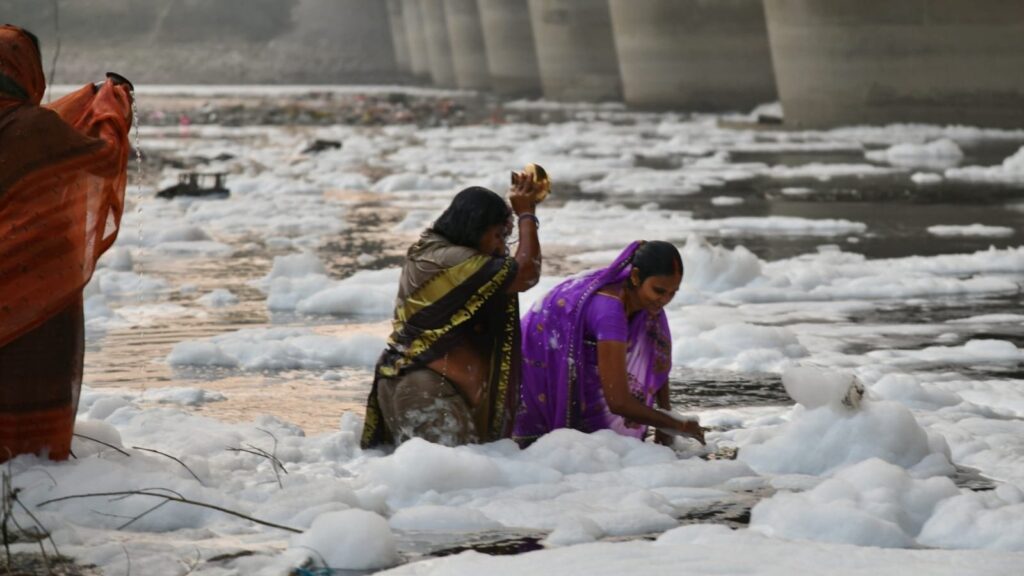Work to tackle the pollution crisis of the Yamuna River commenced on Sunday, as authorities unveiled an ambitious plan to address the severe environmental degradation that has plagued the river for decades. The initiative, which aims to cleanse the river within the next three years, comes after weeks of political discussions and intense campaigning.
The move follows the Bharatiya Janata Party’s victory in the Delhi elections, where the issue of Yamuna’s pollution featured prominently. The BJP accused the Aam Aadmi Party , the ruling party in Delhi, of failing to fulfil its promises to restore the river. The long-standing environmental concern has gained significant attention, with activists, environmental experts, and the general public urging government action.
The plan, designed to be implemented in phases, includes a four-pronged strategy aimed at reducing the river’s pollution levels significantly. Experts argue that this comprehensive approach is necessary to tackle the multiple sources of contamination affecting the water body. One of the most critical aspects of the plan involves the upgrading and expansion of the sewage treatment infrastructure, as untreated sewage is one of the primary contributors to the Yamuna’s pollution.
The government has also proposed the construction of additional sewage treatment plants along key sections of the river. These plants will treat the city’s waste before it enters the Yamuna, significantly reducing the pollutants that flow into the river. With a growing population and inadequate waste management infrastructure, the river has become a repository for untreated sewage, further exacerbating its pollution levels.
Along with sewage management, the strategy aims to address industrial waste and encroachments on the river’s banks. There are plans to close down illegal dumping zones and regulate the disposal of industrial effluents, which have contributed to the degradation of the river’s ecosystem. Environmentalists have long warned about the detrimental effects of untreated industrial discharge, which often contains hazardous chemicals.
Another key component of the plan is riverfront development, which focuses on creating green spaces along the Yamuna banks. These areas will be designed to act as buffer zones, preventing further contamination while promoting public awareness and community involvement in river conservation efforts. The government also hopes to establish eco-friendly initiatives to restore biodiversity along the river’s banks and to foster greater public participation in river-cleaning drives.
Political tensions surrounding the Yamuna’s pollution escalated during the Delhi elections, with the AAP and BJP accusing each other of neglecting the issue. The AAP, which governs Delhi, had earlier promised a comprehensive plan to clean the Yamuna but faced criticism for not meeting its targets. The BJP capitalized on these failures, positioning themselves as the party with a clearer vision for the river’s restoration. The issue became a rallying point in the elections, with the BJP vowing to take immediate action upon their victory.
Following their win, the BJP has outlined their strategy to bring about visible improvements within three years, a timeline that has been met with both hope and skepticism. Some environmental experts have praised the initiative, while others have warned that the challenge is far more complex than the government’s projections suggest. Despite these concerns, there is consensus that any step forward to mitigate the pollution is a step in the right direction.
The Yamuna, one of India’s most important rivers, has suffered significant pollution over the years due to rapid urbanization, industrialisation, and population growth. The river, which flows through multiple states including Delhi, Haryana, and Uttar Pradesh, serves as a critical water source for millions of people, yet its water quality has deteriorated to hazardous levels. The river’s condition has long been a symbol of broader environmental and governance challenges, with failed attempts at restoration highlighting the systemic issues in pollution management and urban planning.
Experts also stress that cleaning the Yamuna will require not just the government’s intervention but also collective action from residents, industries, and local bodies. Efforts to clean the river must go hand-in-hand with sustainable development practices and a commitment to protecting its ecosystem. Stakeholders from various sectors, including environmental groups and urban planners, argue that long-term success can only be achieved through cooperation across political lines, ensuring that future governments continue to prioritize the river’s health.
As the clean-up operation begins, the government has promised regular monitoring and transparent reporting on the progress of the initiative. However, with the election results still fresh in the public’s mind, the pressure is on for the BJP to deliver on its commitments. Success or failure will likely influence the political landscape in the years to come, especially as the next round of state elections approaches.




 Tamil Nadu Rejects Minister’s Threat Over Language Policy
Tamil Nadu Rejects Minister’s Threat Over Language Policy 